Hanko/Inkan: A Guide to the World of Japanese Signature Seals

This article will explain the meaning of "hanko," how to buy and use one. If you are a foreigner who is planning to live in Japan for a while, you will probably have to set up a bank account as well as apply for a phone and public utilities. When signing an application form, you may notice that the space provided for signature is quite small. The reason for this is that when a person "signs" an official document in Japan, they use a personal name stamp called a "hanko" or an "inkan" instead of a written signature like in most other countries.
What is a "Hanko" or "Inkan"?
A “hanko” or “inkan” is a personal stamp that is traditionally used in lieu of a handwritten signature in Japan. One may wonder what is the difference between a hanko and inkan? Originally, the word "hanko" referred to the instrument itself, whereas "inkan" meant a sealed impression or imprint. Nowadays these two words are used interchangeably by many native Japanese speakers. However, depending on the situation, one term may be more appropriate than the other. In casual conversation, the word "hanko" is frequently used, whereas the word "inkan" gives a slightly formal impression.
Why Would You Need a Hanko?
There has been a lot of talks recently in Japan about the abolition of hanko stamps. Many of us may be wondering if we really need one these days. Although it appears that the use of hanko stamps may be somehow limited in the future, it is still difficult, if not impossible, to avoid using one on certain occasions. Whether you want to open a bank account or buy a house, having a hanko will simply make your life in Japan much easier.
Types of Hanko/Inkan
In everyday life in Japan, the following three types of seals are usually used:
1. "Mitome-in"
(means a hanko for casual informal acceptance or acknowledgment):
This is an unofficial, unregistered personal seal used in situations such as receiving home-delivery service packages and for "kairanban," which is a shared neighborhood notice.
A rubber stamp or one that is mass produced with inexpensive materials is generally used for this type of hanko.
Because it may be commonly used by all family members, most times only the last name is chiseled for it, though even a nick name may occasionally be used. These mass-produced, identical, and non-official seals are basically not valid for banks or formal contracts.
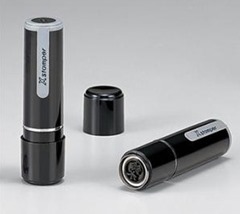

2. "Ginko-in"
(means a hanko for your bank accounts):
This is an official seal used for identity verification procedures (confirmation of identity) at a bank, and it is registered with the bank when an account is opened. The seal is used when you apply for automatic withdrawal of the monthly charges of electricity, gas, and water from your bank account, as well as for withdrawing some cash from the bank teller counter. At each time of such transactions, the bank teller collates the seal impression you registered. Therefore, a seal that is too small or casual is inappropriate. It is recommended that "ginko-in" should be different from "mitome-in," which may be commonly used by the family members. It is advisable to use a middle-sized seal with 13.5-15mm diameter, and with engraved name letters appropriate for your identity verification. For further details please ask your bank or other financial institutions.
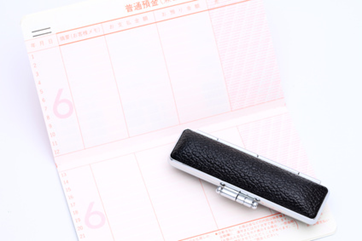
3. "Jitsu-in"
(means the "real" registered hanko):
This is the official and most important seal. It is used for serious contractual matters such as a mortgage loan contract when purchasing a house. In order to become a "jitsuin," a hanko must be registered at the city hall or the local government office that has jurisdiction over the area you live. It is possible to register a seal that bears your "full name", "only family name", "only first name", or your "legal alias", all of which should have been already recorded on the Basic Resident Register at the government office.
The size of the seal is restricted to fit within a square with the sides being between 8mm to 25mm. There is no regulation to the shape of the impression. Only one seal can be registered as "jitsu-in" per person. Please contact your city hall or local government office for additional information concerning name letters, fonts for the impression, and any other questions.
Because "jitsu-in" is an official seal used for important contract matters, generally it should be different from "mitome-in" and "ginko-in", and the size of its imprint should be not too small. Using high-quality, long-lasting materials for this type of hanko is strongly advised.
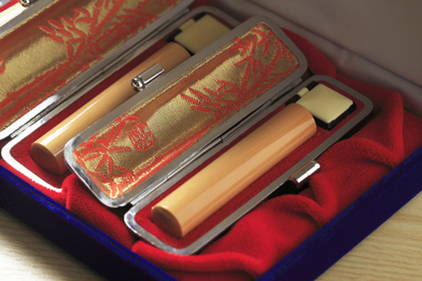
Registration and Certificate of Seal Impression
After completing a seal registration, "inkan torokusho" or "inkan toroku card" (a seal registration card) is issued and handed to you. You can get "inkan shomeisho" (certificate of a seal registration) for a small fee every time you need it by showing your seal registration card. “Inkan shomeisho” is required for and usually attached to contracts made with "jitsu-in" because it proves the seal used is properly registered. Nowadays many city halls and local government offices issue "inkan shomeisho" by "inkan toroku card" through an automated machine, even during the night and on holidays.
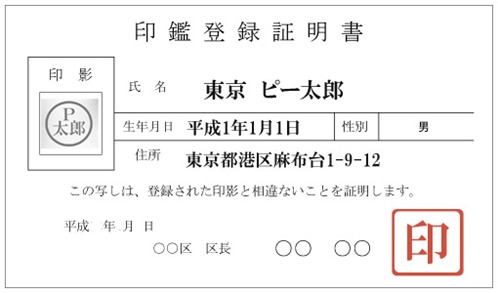
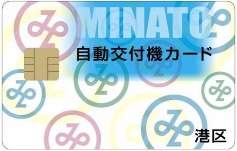
What Should I Do If I Lost My Hanko?
Losing our valuables is not only frustrating, but also very stressful. No need to worry! Even if you have lost your precious hanko, you can get back on track by following certain procedures.
While it is necessary to be careful about the safekeeping of your seals, special care should be taken to ensure that your "ginko-in" and "jitsu-in" are protected and safe. If you happen to lose either of them, please contact the bank and government offices concerned. It is of the utmost importance to invalidate the lost seal immediately. Reporting the loss of your hanko to police is strongly advised.
In case of a “jitsu-in,” you would also need to cancel the registration of it by submitting necessary documents to the relevant government office (the place you registered your “jitsu-in”). Once your lost “jitsu-in” is cancelled, you would need to register a new one.
For further details on how to deal with lost seals or any other questions, please ask your bank or local government office.
How to Buy Hanko/Inkan?
When a foreigner creates a seal, a custom one is usually required. There are several ways to have your name chiseled, including converting it to katakana, alphabetical, or even kanji writing. You have the option of having your name written (engraved) from left to right, or top to bottom. There is also a great variety of alphabet fonts available. The materials and number of letters in a seal vary depending on the intended use. Each hanko/inkan store provides you with various suggestions and sample presentations to ensure that the production of your custom-ordered hanko goes as smoothly as possible. Please contact a hanko store or the organization concerned for more information.
The following is a list of our store recommendations:
Order on Amazon Japan
Click the image(s) to see details
The stores available for order in English:
■ SHIBUYA HANKO-DOU
http://shibuya-hanko.com/english-version/
■ JUN JAPANESE GIFTS & SOUVENIRS
http://www.jun-gifts.com/personalizedgifts/hanko/hanko1/hanko1.htm
■ HANKO SHOP RAKUZENDO
http://www.name-stamp.tokyo/online-shop/
■ INKANHANKO.COM
http://www.inkanhanko.com/inkan_foreign/index.html
The stores available for order by foreigners (In Japanese Only):
■ HANTAROU.COM
http://www.hantarou.com/point003.html
The stores available for novelty seals with illustrations (In Japanese Only):
■ OSUMON
Honorable Mention
■ TOKYU HANDS
http://www.tokyu-hands.co.jp/en/list/
Tokyu Hands is a well-known department store with numerous locations throughout Japan. Going to one of their stores is one of the quickest ways to get your hanko made. When you arrive, look for a counter or staff member who can assist you with your inquiry. Because the staff may not speak English, going with someone who speaks Japanese is advised.
Even though the variety of materials available is rather limited, Tokyo Hands can be recommended as a great place for those of us who have a limited budget or don't have much time. Since services may vary from store to store, it is advisable to check in advance if it is possible to order a hanko at your local Tokyu Hands store.

- Rental Apartments & Houses in Tokyo
- Listings of popular and luxurious rental apartments, condominiums, and houses
- designed with expats in mind.

- Apartments & Houses for Sale in Tokyo
- Listings of apartments, condominiums, and houses available for purchase in Tokyo.




















